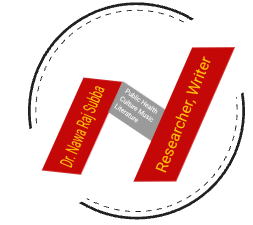Nawa Raj Subba
To cite the article: Nawa Raj Subba. (2003). Demographic Assessment on Vasectomy Clients of Sankhuwasabha Nepal. Nepal Medical College Journal. Vol.5, No.2, December 2003, pp98-99.
ABSTRACT
This paper presents the demographic status of vasectomy clients in Sankhuwasabha district in Eastern Nepal based on the 427 fact-sheets taken at camps in the district for 3 consecutive years. More than half (55.0%) of the clients were Brahmin and Chhetri. The major occupation of clients was agriculture (73.7%) with the literacy rate of 83%. Mean age of vasectomy clients and their wives was 32.5 and 28.7 years respectively and age of the youngest female child was 3.9 years. Of the total, 55.8% couple had used temporary contraceptives before having the vasectomy. As a part of the screening procedure, blood pressure of more than half clients (54.6%) was measured and found to be within normal range.
INTRODUCTION
It has been experienced that vasectomy target could not have been achieved in hilly and mountainous districts compared to districts located in plain (Terai) areas in Nepal.1 This has been due to the lack of doctors and other management problem for years. In addition, there might be socio-cultural reasons as well.
This paper presents the findings of a cross-sectional study done to assess the demographic, social and personnel characteristics of vasectomy clients in Sankhuwasabha district, one of the Himalayan districts located in Koshi zone in Eastern Development Region.
MATERIALS AND METHODS
Face-Sheets1 were taken from the vasectomy clients. A total of 427 Face-Sheets was taken as samples that were filled up at the time of Vasectomy conducted Fiscal Years 056/57, 057/58 and 058/59 covering District Hospital 1, Primary Health Care Centre 1, Health Posts 12, Sub-Health Posts 25 of Sankhuwasabha district. Data from pre-coded questions were entered into Epi Info 6.0 database and were analyzed using Epi-Info Statistical package.
RESULTS
This paper presents the demographic status of vasectomy clients in Sankhuwasabha district in Eastern Nepal based on the 427 face-sheets taken at camps during 3 consecutive years. More than half (55.0%) of the clients were Brahmin/Chhetri (Table 1). Major occupation of clients was agriculture (73.7%) with literacy rate 83.0% (Table 2). Mean age of vasectomy clients and their wives was 32.5 and 28.7 years respectively. An average number child of a client was 3.2 years. Age of youngest male child was 4.7 years and the female child was 3.9 years. Of the total, 55.8% couple have had used temporary contraceptives before having vasectomyThe age of the last male and the female child was 4.7 and 4.0 years, respectively.
Table 1. Ethnics of Vasectomy Clients in Sankhuwasabha District
| Ethnics
Brahmin/ Chhetri |
Total n
103 |
Percentage
55.0 |
| Rai/Limbu | 74 | 17.3 |
| Gurung/Magar | 55 | 12.8 |
| Tamang/Sherpa | 19 | 4.4 |
| Newars | 5 | 1.2 |
| Vaishya/ Dalits | 39 | 9.1 |
| Total | 427 | 100% |
Table 2. Occupation of Vasectomy Clients and their spouse in Sanlhuwasabha District.
| Occupation | Client | Spouse |
| Agriculture | 314 (73.7%) | 314 (73.7%) |
| Service | 91 (21.4%) | 91(21.4%) |
| Business | 20 (4.7%) | 20 (4.7%) |
| Dependant | 1 (0.2%) | 1(0.2%) |
| Total | 427 | 427 |
Table 3. Educational status of Vasectomy clients
| Educational status | Number (n=425) | Percentage |
| Illiterate | 73 | 17.2 |
| Literate | 153 | 36.0 |
| Under SLC | 78 | 18.4 |
| SLC | 68 | 16.0 |
| IA and above | 53 | 12.5 |
Table 4. Type of contraception used by the clients
| Temporary Contraception | Percentage |
| Condom | 32.8 |
| Pills | 7.8 |
| Depo-Provera | 57.8 |
| IUD | 1.3 |
| Norplant | 0.4 |
Table 3 shows the educational status of clients. Approximately one-fifth of vasectomy clients were illiterate. Over two-third clients could read and write. Small number had an education above SLC. Seven percent of clients had experienced loss of their child before the vasectomy.
As a part of the screening procedure, blood pressure of more than half clients (54.6%) was measured and found to be within normal range.
DISCUSSION
In Nepal, 30.0% of the total population is comprised of Brahmin/Chhetri.2,3 In Sankhuwasabha district Brahmain/Chhetri is 55%.3 Most of the people in this district are engaged in agriculture and this was well reflected in this study as well (74.0% clients were involved in agriculture). In Terai, the occupational figure is slightly different and only half (52.0).4 onvolved in agriculture.
The illiteracy rate in Sankhuwasabha district6 is 50.8% (literacyrate of Nepal is 53.7%).3 However, the literacy rate of clients was 83% indicating that educatin (awareness) of people plays a great role in family planning by vasectomy. The mean age of vasectomy clients is studied in this study (32.5 years) was similar to the mean age of vasectomy clients in the USA (31 years).5 In Nepal, the mean number of children ever born at age 25-29 women group is 2.71 whereas the mean number of living children of the same age group is 2.43 children.3 However, the mean number of children ever born at age 25-29 women group of the vasectomy clients in Sankhuwasabha district was 3.3 and mean number children children of the same age group was 3.2 children.
It has been found that 39.0% women and 44.0% men were on temporary contraception practice in the Eastern mountainous region.4 In this study the number was low, 18% men and 37% women had used a temporary method of contraception prior to the vasectomy. About ten percent of newly married non-pregnant women in Nepaluse injectable contraception (Depo-Provera)1 while 25.6% women of 15-29 years age group have taken (Depo-Provera).4 Overall, Depo-Provera user married women of reproductive age in Eastern Nepal ws 31%6 However, 57.8% of vasectomy clients revealed that their wives had used Depo-Provera. None of the subjects had symptoms of hypertension and might be associated with their life-style.
These results may reflect and confined to the study district’s situation. However, the present study is based on the face-sheets. In this district, certain caste/ethnic groups are still far from the access of vasectomy contraception the program focusing in this regard should be encouraged.
REFERENCES
1. DHO, Sankhuwasabha, District Health Office Sankhuwasabha Nepal, Vasectomy Face Sheets, Fiscal Years 2056/56, 2057/58, 2058/59.
2. DBS, Statistical Pocket Book Nepal, His Majesty’s Government Nepal Planning Commission, Central Bureau of Statistics, Kathmandu Nepal, 2002.
3. DDC, District Profile of Sankhuwasabha district, District zDevelopment Committee Sankhuwasabha, 2001.
4. Subba NR, Health Seeking behavior of Rajbanshi ethnic of Katahari and Baijanathpur in Morang, 2001.
5. Vasectomy Project Washington State Family Planning and Reproductive Health, State Department of Health Family Planning and Reproductive Health, P.O. Box 47883, Olympia, Washington, 98504-7883, 2002, www.fprh.index.htm
6. EDR, Annual Report of Eastern Region Fiscal Year 2057/58, His Majesty’s Government of Nepal, Ministry of Health, Department of Health Services, Regional Health Directorate Eastern Development Region, Dhankuta, 2059.






Hey
Really glad to get into this forum
It’s what I am looking for.
Hope to know more member here.